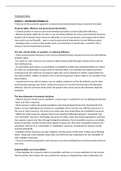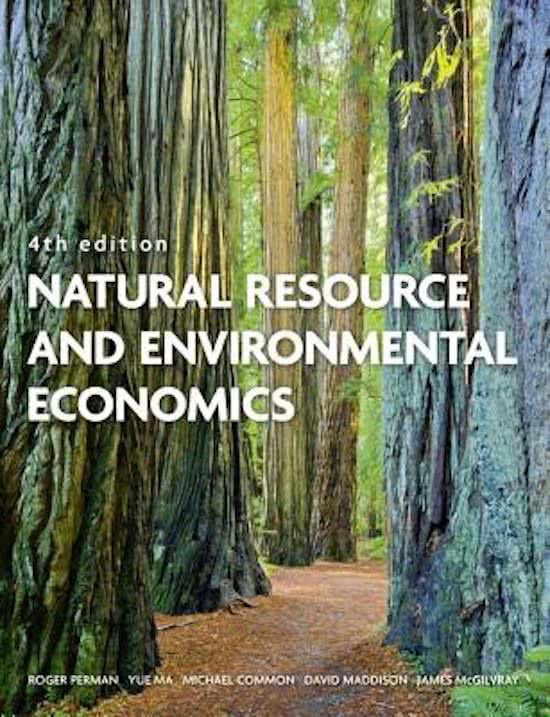Textbook Notes
Lecture 1 – Introduction (Chapter 1):
4 features of the economic approach to resource and environmental issues covered in the book:
Property rights, efficiency and government intervention
> Central question in resource and environmental economics concerns allocative efficiency.
> Because property rights do not exist, or are not clearly defined, for many environmental resources,
markets fail to allocate those resources efficiently. In such circumstances, price signals fail to reflect
true social costs and benefits – gives a case for government intervention to seek efficiency gains.
> Deciding where a case for intervention exists, and what form it should take, is central in all of
resource and environmental economics
The role, and the limits, of valuation, in achieving efficiency
> Many environmental resources or the services yielded by those resources do not have well-defined
property rights.
- E.g. clean air. Such resources are used but without being traded through markets and so will not
have market prices.
- An externality exists where a consumption or production activity has unintended effects on others
for which no compensation is paid. Here the external effect is an untraded and unpriced product
arising because the victim has no property rights that can be exploited to obtain compensation for
the external effect. Sulphur emissions from a coal-burning power station might be an example of this
kind of effect.
> A government may wish to impose a tax on sulphur emissions so that the polluters pay for their
environmental damage and, hence, reduce the amount of it to the level that goes with allocative
efficiency. But this cannot be done unless the proper value can be put on the otherwise unpriced
emissions.
The time dimension of economic decisions
> Natural resource stocks can be classified in various ways. A useful first cut is to distinguish between
‘stock’ and ‘flow’ resources.
- Stock resources, plant and animal populations and mineral deposits have the characteristic that
today’s use has implications for tomorrow’s availability, this is not the case with flow resources. In
the case of stock resources, the level of use today does have implications for availability tomorrow.
- Within the stock resources category there is an important distinction between ‘renewable’ and
‘non-renewable’ resources. Renewable resources are biotic, plant and animal populations, and have
the capacity to grow over time through biological production. Non-renewable resources are abiotic,
stocks of minerals, and do not have that capacity to grow over time. Non-renewable resources are
sometimes referred to as ‘exhaustible’ or ‘depletable’ resources. (Eventually the resource stocks
must be exhausted)
- Examples of flow resources are solar radiation, and the power of the wind, of tides and of flowing
water. Using more solar radiation today does not itself have any implications for the availability of
solar radiation tomorrow.
> From an economic perspective, stock resources are assets yielding flows of environmental services
over time.
Substitutability and irreversibility
> If the depletion of a resource stock is irreversible, and there is no close substitute for the services
that it provides, then clearly the rate at which the resource is depleted has major implications for
,sustainability. To the extent that depletion is not irreversible and close substitutes exist, there is less
cause for concern about the rate at which the resource is used.
> There are 2 main dimensions to substitutability issues
- First there is the question of the extent to which one natural resource can be replaced by another
e.g. can solar power substitute fossil fuels on a large scale? This is an important q given that the
burning of fossil fuels not only involves the depletion of non-renewable resources but also is a
source of some major environmental pollution problems such as the greenhouse effect.
- Second there is the question of the degree to which an environmental resource can be replaced by
other inputs, especially the human-made capital resulting from savings and investment.
- Some pollution problems may involve irreversible effects, and the extinction of a species of plant or
animal is certainly irreversible.
, Lecture 7 – Pollution Control Targets (Chapter 6):
> Economic efficiency is one way of thinking about pollution targets, but it is certainly not the only
way. For example, we might adopt sustainability as the policy objective, or as a constraint that
must be satisfied in pursuing other objectives. Then pollution levels would be assessed in terms of
whether they are compatible with sustainable development.
> Pollution targets may be, and in practice often are determined on grounds other than economic
efficiency or sustainability. They may be based on what risk to health is deemed reasonable, or on
what is acceptable to public opinion. They may be based on what is politically feasible.
> Damage arising from the oil-to-electricity fuel cycle: oil spills on marine ecosystems, public health
e.g. ozone, agriculture, forests, noise, global warming.
The extent to which waste loads generate impacts that are associated with subsequent damage
depends upon several things, including:
- The absorptive capacity of the receptor environmental media
- The existing loads on the receptor environmental media
- The location of the environmental receptor media and so the number of people living there and the
characteristics of the affected ecosystems
- Tastes and preferences of affected people
- Figure 6.3 illustrates some of these ideas
schematically for pollution problems in
general. Some proportion of the emission
flows from economic activity is quickly
absorbed and transformed by environmental
media into harmless forms. The capacity of
the environment will in many circumstances
be sufficient to absorb and transform into
harmless forms some amount of wastes.
- However, carrying capacities will often be
insufficient to deal with all waste in this way,
and in extreme cases carrying capacities will
become zero when burdens become excessive.
- Furthermore, physical and chemical
processes take time to operate. Some
greenhouse gases, for example require
decades to be fully absorbed in water systems
or chemically changed into non-warming
substances.
- This implies that some proportion of wastes
will in any time interval, remain unabsorbed
or untransformed. These may cause damage
at the time of their emission and may also by
accumulating as pollutant stocks, cause
additional future damage. Stocks of pollutant
will usually decay into harmfulness forms, but
the rate of decay is often slow.
- The half-lives of some radioactive substances are thousands of years, and for some highly





